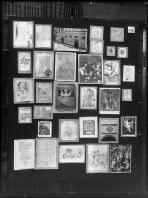Fortuna and the Renaissance Everyday
The key iconology of the second sequence is initiated by the Hadrianic coin (#10), at the very top of the panel. It depicts Isis Pelagia steering a ship, thus introducing not only the naval theme to the panel, but further stating that the theme’s rootedness lies in how commerce flourished during Antiquity. They fully conjure up the merchant, whom Warburg had given the paradigmatic role as the Fortuna-oriented “self-liberating man” in the title. A second coin below it (#11) transfers the merchant theme to the 16th century, when it comes to represent the early modern individual as such, here the Milanese lawyer Alessandro Caimo. It suggests that life itself is increasingly characterized by the multiplication of options. The coin’s maritime iconology and motto “the desirable voyage” (“Optanda Navigatio”) render Fortuna as the only operator capable of integrating all aspects of this life. Next to it we see a contemporary photograph of the palazzo Rucellai in Florence (#9), which does not show any reference to the panel’s theme, but functions as a visual metonymy for a patrician family’s century-long struggle with Fortuna’s impositions. More particularly, the Rucellai for Warburg exemplify a Renaissance “type.” Beginning in the late 1880s, Warburg had a crucial interest in the emergence of the modern individual and how this “Einzelperson” achieved the self-recognition of its own novel form of life only through the interaction with art and specific motifs. In this regard the panel’s interest is generalized towards asking how much a Renaissance person’s everyday life actually depended on swaying Fortuna through artworks. We see that the pagan Fortuna enters the dome of Siena (#13), that a single fluttering sail becomes her symbol in Giorgio Martini’s 1470s drawing of Hippo, an abducted Greek woman who drowned herself rather than awaiting impending rape (#16), and finally, in a 1506 engraving (#14), Fortuna has developed her full set of insignia, which she uses to direct the world – wind, sail, rudder, and globe. Later in the 16th century even St. John awaiting the Revelation will feel her influence, i. e. her full blown sails announce his vision, just off the shores of Patmos (#15). Dürer’s 1502 “Nemesis” or “The Great Fortune” (#26), however, already combines Fortuna’s richness and success with Nemesis’s abiding power, thus recalling a reality in which both have an equally balanced influence on the individual.
